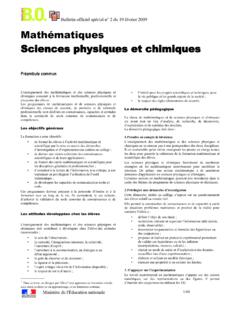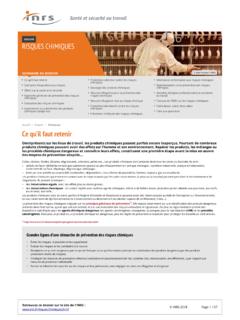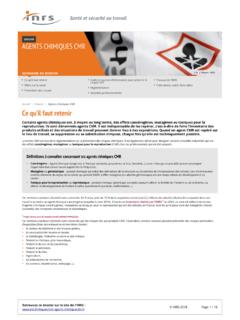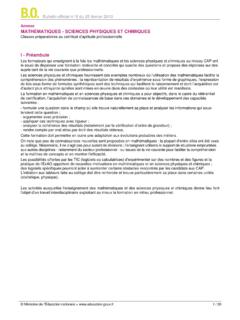Transcription of ACROLEIN - WHO
1 This report contains the collective views of an international group of experts and does not necessarilyrepresent the decisions or the stated policy of the United Nations Environment Programme, theInternational Labour Organization, or the World Health International Chemical Assessment Document 43 ACROLEINF irst draft prepared by R. Gomes and Meek, Existing Substances Division, Bureau of Chemical Hazards, HealthCanada, Ottawa, Canada, andM. Eggleton, Environment Canada, Hull, QuebecPlease note that the layout and pagination of this pdf file are not necessarilyidentical to those of the printed CICADP ublished under the joint sponsorship of the United Nations Environment Programme, the InternationalLabour Organization, and the World Health Organization, and produced within the framework of theInter-Organization Programme for the Sound Management of Health OrganizationGeneva, 2002 The International Programme on Chemical Safety (IPCS)
2 , established in 1980, is a joint ventureof the United Nations Environment Programme (UNEP), the International Labour Organization (ILO),and the World Health Organization (WHO). The overall objectives of the IPCS are to establish thescientific basis for assessment of the risk to human health and the environment from exposure tochemicals, through international peer review processes, as a prerequisite for the promotion of chemicalsafety, and to provide technical assistance in strengthening national capacities for the sound managementof Inter-Organization Programme for the Sound Management of Chemicals (IOMC)
3 Wasestablished in 1995 by UNEP, ILO, the Food and Agriculture Organization of the United Nations, WHO,the United Nations Industrial Development Organization, the United Nations Institute for Training andResearch, and the Organisation for Economic Co-operation and Development (Participating Organiza-tions), following recommendations made by the 1992 UN Conference on Environment and Developmentto strengthen cooperation and increase coordination in the field of chemical safety. The purpose of theIOMC is to promote coordination of the policies and activities pursued by the Participating Organizations,jointly or separately, to achieve the sound management of chemicals in relation to human health and Library Cataloguing-in-Publication DataAcrolein.
4 (Concise international chemical assessment document ; 43) - adverse effects - toxicity assessment exposure Programme on Chemical Safety 92 4 153043 X (NLM Classification: QV 627) ISSN 1020-6167 The World Health Organization welcomes requests for permission to reproduce or translate itspublications, in part or in full. Applications and enquiries should be addressed to the Office of Publications,World Health Organization, Geneva, Switzerland, which will be glad to provide the latest information onany changes made to the text, plans for new editions, and reprints and translations already available.
5 World Health Organization 2002 Publications of the World Health Organization enjoy copyright protection in accordance with theprovisions of Protocol 2 of the Universal Copyright Convention. All rights designations employed and the presentation of the material in this publication do not imply theexpression of any opinion whatsoever on the part of the Secretariat of the World Health Organizationconcerning the legal status of any country, territory, city, or area or of its authorities.
6 Or concerning thedelimitation of its frontiers or mention of specific companies or of certain manufacturers products does not imply that they areendorsed or recommended by the World Health Organization in preference to others of a similar naturethat are not mentioned. Errors and omissions excepted, the names of proprietary products aredistinguished by initial capital Federal Ministry for the Environment, Nature Conservation and Nuclear Safety, Germany,provided financial support for the printing of this by Wissenschaftliche Verlagsgesellschaft mbH, D-70009 Stuttgart 10iiiTABLE OF AND PHYSICAL/CHEMICAL OF HUMAN AND ENVIRONMENTAL and TRANSPORT, DISTRIBUTION.
7 AND LEVELS AND HUMAN and exposure: exposure: KINETICS AND METABOLISM IN LABORATORY ANIMALS ON LABORATORY MAMMALS AND IN VITRO TEST and and medium-term exposure and and related and effects on the immune of toxicity / mode of 19 Concise International Chemical Assessment Document ON ON OTHER ORGANISMS IN THE LABORATORY AND Evaluation of health 22 identification and exposure response Effects in Effects in experimental for setting tolerable
8 Intakes/concentrations or guidance 26 risk 27 in the evaluation of health Evaluation of environmental environmental risk exposure of terrestrial plants and exposure of terrestrial plants and in the evaluation of environmental EVALUATIONS BY INTERNATIONAL 31 APPENDIX 1 SOURCE 39 APPENDIX 2 CICAD PEER 39 APPENDIX 3 CICAD FINAL REVIEW 40 INTERNATIONAL CHEMICAL SAFETY 41R SUM D 43 RESUMEN DE ORIENTACI 45 Acrolein1 FOREWORDC oncise International Chemical AssessmentDocuments (CICADs) are the latest in a family ofpublications from the International Programme onChemical Safety (IPCS) a cooperative programme ofthe World Health Organization (WHO), the InternationalLabour Organization (ILO), and the United NationsEnvironment Programme (UNEP).
9 CICADs join theEnvironmental Health Criteria documents (EHCs) asauthoritative documents on the risk assessment Chemical Safety Cards on therelevant chemical(s) are attached at the end of theCICAD, to provide the reader with concise informationon the protection of human health and on emergencyaction. They are produced in a separate peer-reviewedprocedure at are concise documents that provide sum-maries of the relevant scientific information concerningthe potential effects of chemicals upon human healthand/or the environment.
10 They are based on selectednational or regional evaluation documents or on existingEHCs. Before acceptance for publication as CICADs byIPCS, these documents undergo extensive peer reviewby internationally selected experts to ensure theircompleteness, accuracy in the way in which the originaldata are represented, and the validity of the primary objective of CICADs is characteri-zation of hazard and dose response from exposure to achemical. CICADs are not a summary of all available dataon a particular chemical; rather, they include only thatinformation considered critical for characterization of therisk posed by the chemical.
















